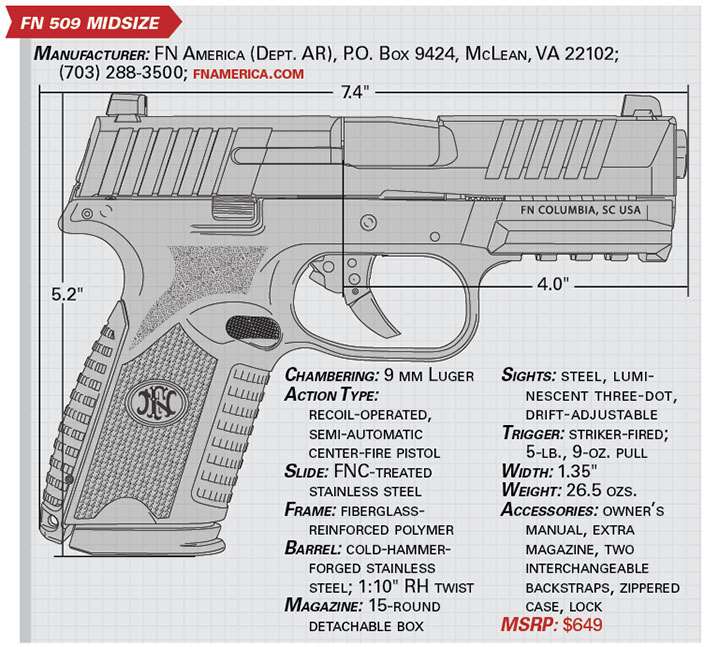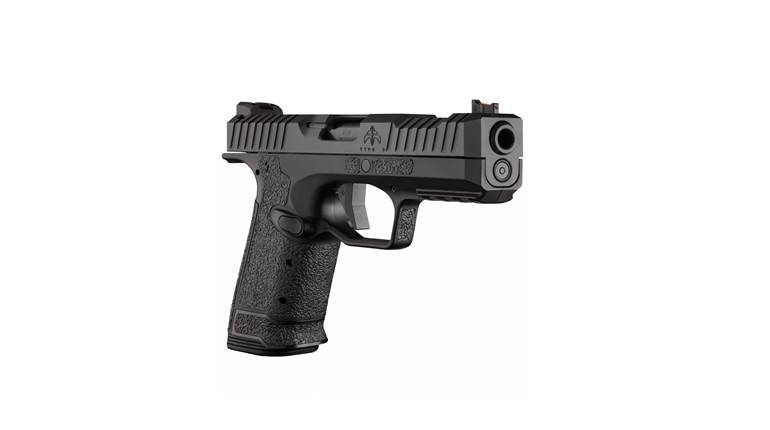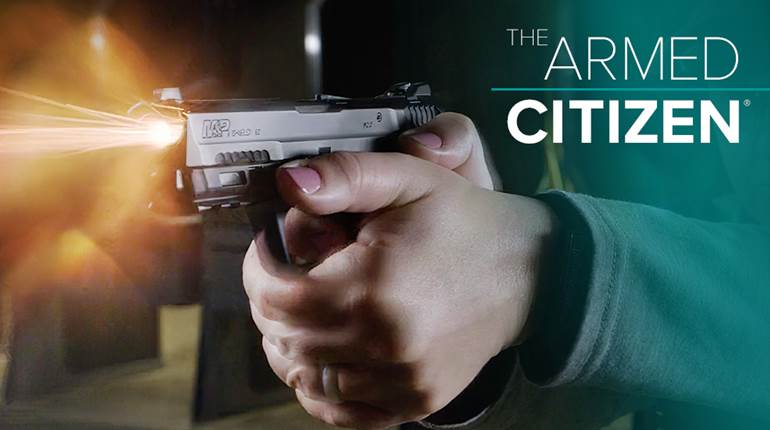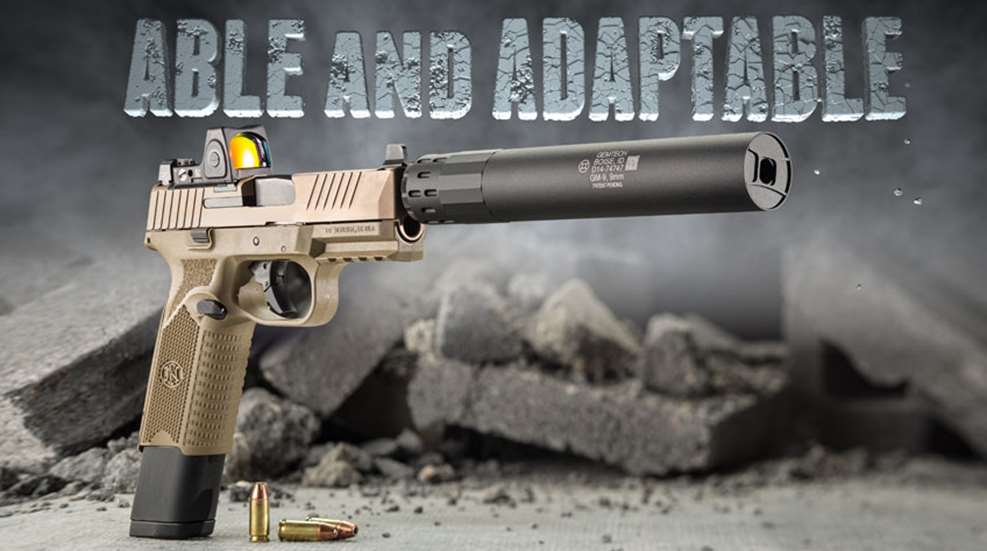
The FN 509 Tactical is shown here with its factory 24-round magazine in place. The gun’s rear sight ears have been removed and an optics plate has been installed with a Trijicon RMR. Also, a Gemtech GM-9 9 mm suppressor has been fitted to the 509’s threaded barrel. (The RMR and suppressor are not included.)
When the subject of “iconic” handguns comes up, nearly every example that springs to mind resulted from a major military or police trial. The Colt Peacemaker? Purpose-built for the U.S. Army in 1873. The Colt Model of 1911? Ditto, and selected in 1911. The Luger gained recognition and traction once it became a German military sidearm. Our early 1980s military trials brought us the Beretta 92FS/M9, which went on to star in every major action movie of the era and make serious inroads into law enforcement. And what did the Beretta replace in cops’ holsters? The Smith & Wesson Military & Police, developed 90 years earlier in hopes of military contracts. The M9 trials also brought us the iconic SIG P226, imported in early form prior to the trials but exploding in popularity after its near win. The list goes on. The recent XM17 service pistol trials boosted its finalists in like manner, and the FN America 509 Tactical is one such example.
The FN 509 Tactical is an American-made, striker-fired service pistol that is configured to accommodate red-dot optics and suppressors. The earth-colored pistol mates a full-size frame to a midsize PVD-finished slide with a 4.5" threaded barrel protruding to allow suppressor use. The 509 Tactical ships with a flush-fitting, steel, 17-round magazine and two extended 24-rounders.
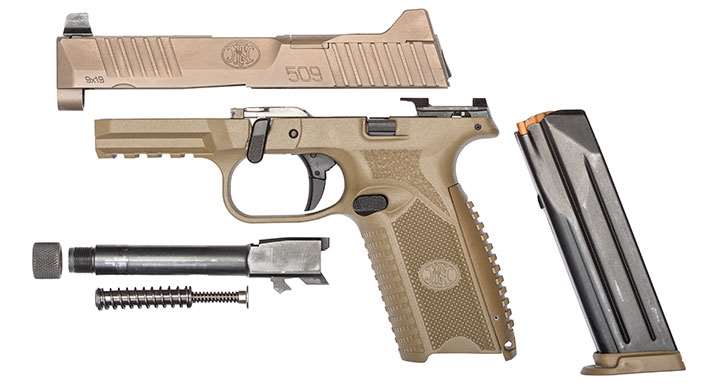
Quality
Upon initially picking up the 509 Tactical I was immediately struck by its apparent quality. The striker-fired genre is not particularly well-known for crisp roll marks or perfectly smooth, polished flats meeting gently radiused curves; the archetype is much more utilitarian than that. One can’t help but notice, then, the effort FN invested to ensure a high degree of fit and finish. Even the various textures and curves on the polymer frame have been molded with a level of care that seems, well, nicer than one typically encounters in the genre.
Looking at some of the shapes and curves on the frame, I strongly suspect that the designers looked hard at some of the industry-leading shops doing custom stippling work on polymer pistols. The feel of critical areas, such as the underside and base of the trigger guard, and the approach for the thumb to hit the magazine release, remind me strongly of some of the high-end Boresight Solutions striker-fired pistols I’ve handled. The molded texturing is effective without being abrasive to the casual shooter, and worked well both with gloves and barehanded. The pistol ships with different backstraps in its zippered nylon case to adapt it to multiple hand sizes or preferences.
The 509 Tactical incorporates a relatively low-profile mounting surface for a mini red-dot sight. When the iron sights are in use, a cover plate with unique built-in “wings” protects the rear sight and provides a robust area for one-handed, emergency manipulation of the slide. With the cover plate removed, the optic mounting system struck me as well-thought-out and secure. It comes with a kit of optic-mounting plates, spacers and screws to accommodate nearly a dozen of the most popular miniature red-dot optics in a manner that is secure and low to the slide. For testing, I equipped a Trijicon RMR RM09 to the evaluation pistol, and can report that the optic was rigidly affixed and well-protected, and showed absolutely no signs of loosening during testing.

Controls
One of the areas where the 509 really stands out is in its bilateral controls. The maker has made significant progress in this area as a whole, but the 509 is a fully bilateral pistol. Both the slide and magazine releases are mirrored in terms of size, placement and function. The locations of the controls worked out well for my hands; in no time I was besting my normal “good” time for reloads on some of the other polymer service pistols by up to two-tenths of a second.
The slide is angled as well as serrated at the front, allowing excellent manipulation from the forward portion of the slide. The rear serrations are deep and effective as well. This is perhaps a small detail, but well-rendered serrations allow for very positive manipulations under less-than-ideal circumstances (cold, wet, stress, etc.) and can boost a less experienced shooter’s confidence in handling the pistol.
The sights on the Tactical are robust and tall enough to clear many suppressors. The front is well-shaped and thin for a unit housing tritium, while the notch is a good balance of enough width to work in a wide variety of lighting conditions and at max recovery speed, yet not “sloppy wide,” and allows for good precision. These may be my personal favorite sights from among the most current batch of service pistols.
When talking about either single-action semi-automatics or even double-action/single-action pistols there is often a repeatable consensus on what a “good” or “bad” trigger is. When dealing with the quirks of the trigger release on a striker-fired pistol that is often not the case, and “good” becomes subjective and personal. What one shooter finds good another worries may be unsafe since the primary safety tends to be a part of the trigger. Where one shooter finds a “crisp” break another may find it “crunchy,” and one man’s smooth roll is another’s creep.
The 509 Tactical has a hinged trigger with a smooth, medium-weight take-up and then a release that rolls predictably through a break. Total weight straight through was 5 lbs., 9 ozs., of pressure, with that breaking down into a very repeatable 2 lbs., 3 ozs., of pre-travel and 3 lbs., 6 ozs., at the break. I had no trouble adapting to it and using it well, and found it to be a good balance between shootable and safe. Considering the 509 Tactical’s origin as a prospective combat pistol, the trigger on this gun is sensible, although it is not an immediate standout feature compared to some in its class.
Performance
The FN 509 Tactical grouped well with a variety of loads, besting 2" on average with FMJ Black Hills and cutting 1¼" with both the Black Hills and Federal HST best groups. Beyond being able to print respectable groups from a rest, the 509 Tactical was able to produce in hand. For as long as the military has quantified such things, the maximum effective range for our service pistols has been listed as 50 yds. (or meters, depending on the time and manual). At 50 yds. I was still hitting 8" MGM steel plates, and ringing a 10"x20" reduced silhouette at 70 yds. I suspect that many of the Marines I served with would have no trouble keeping hits on a military silhouette out to 100 yds. or more with the 509, particularly with an optic mounted.
Running the 509 Tactical inside of more traditional distances the pistol was clearing the plate rack in similar time frames to my Glock 34 set up for 3-gun competitions. Even with no familiarity on the platform, the FN was showing potential in practical drills that tilted toward either speed or accuracy. For example, late firearm trainer Todd Green’s Fundamentals, Accuracy & Speed Test (FAST) has two shots to a 3"x5" card from the holster, a slide lock reload, and then four shots to the 8" center of a silhouette at 7 yds. Under 5 seconds on the FAST is a well-established benchmark for noteworthy performance and one that I can’t produce with just any pistol. Shooting the 509 Tactical from a Safariland level two retention holster, the FN posted a clean 4.76-second run on my third attempt.
One feature that I appreciated with the 509 Tactical was the inclusion of an additional reduced-power recoil spring. Today, 9 mm Luger service pistols see a really wide range of ammunition at differing levels of pressure (and recoil). If a pistol is correctly sprung for 9x19 mm NATO spec and +P service loads, then it is almost certainly oversprung for lightweight, moderate-speed bulk practice ammunition or minimum-power-factor competition loads. The pistol was perfectly reliable with the normal spring but was more pleasant to shoot with the lighter spring with mild loads. I would like to see more manufacturers follow FN’s lead here.
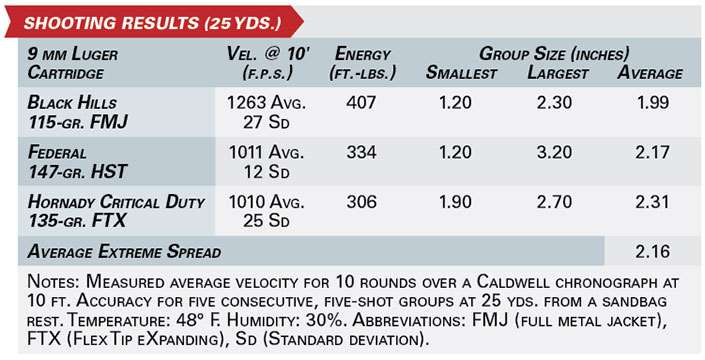
Speaking of reliability, I fired about 1,000 rounds between both of the newest 509 models—see sidebar below on the 509 Midsize—with no issues to report. With the amount of testing behind the 509 and FN’s reputation for quality control, I would have been surprised had there been any issues.
Fabrique Nationale’s manufacturing plant in Columbia, S.C., is mostly known for its high-profile government long-gun contracts: the M240 and other machine guns, the M16A2/M4 family, etc. Coming off the XM17 trials, the 509s could re-establish FN’s reputation as a premier handgun maker, much as the High Power did for an earlier generation.
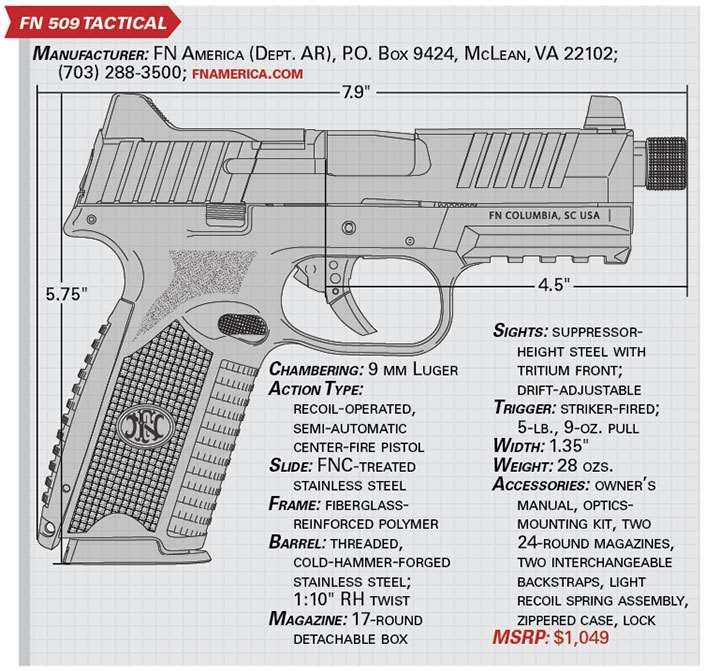
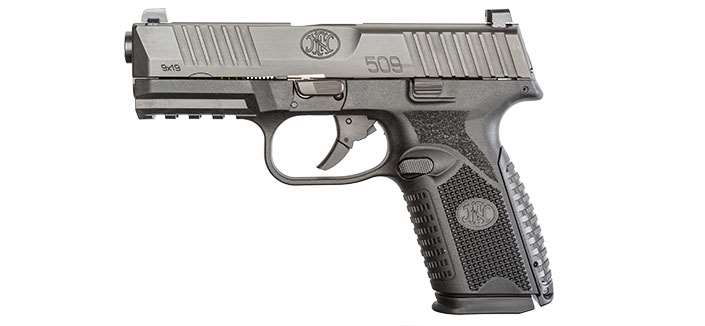
Going Medium: The 509 Midsize
Introduced for SHOT 2019, the 509 Midsize is a more compact, non-optic-ready version of the Tactical that mates the larger gun’s slide to a slightly shorter frame that houses 15-round magazines. The frame is just tall enough to allow even large hands a full, four-finger grasp in a slightly more concealable footprint.
The Midsize differs from the Tactical in small ways aside from size. For instance, the Midsize’s trigger actually has a somewhat flatter engagement face compared to the Tactical. The trigger also breaks with less roll in a more distinct fashion, with total weight identical at 5 lbs., 9 ozs.
The second change is also quite subtle; FN has enhanced the texturing on the backstrap to provide a bit more purchase. Aside from those areas, the two pistols are quite similar. Since there is no suppressor requirement for the Midsize, the pistol wears a set of lower-profile, steel sights that have a luminescent three-dot arrangement. The sights are usable, if not quite as visible as tritium, as long as there is enough ambient light to clearly identify a target.
Shooting the Midsize was a very similar experience to firing the larger Tactical model. Most would have to break out a timer to notice the slight difference in recovery from the larger pistol. An aspect that I appreciated was the similarity in overall feel between the full- and mid-size models. Some pistol families seem to feel and point ever so slightly apart when switching from the “large” to “medium” models; I found the 509s to be particularly close.
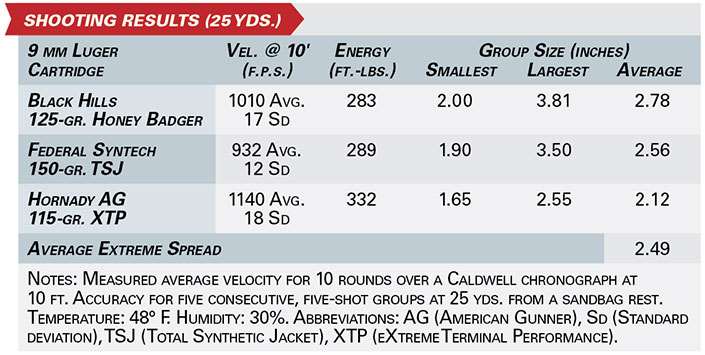
The 509 Midsize is a robust pistol that handles well and feels like a full-size pistol just trimmed back to a more carry-friendly package. The 509 design is fairly thick through the slide at 1.35". I think this contributes to how easy it is to manipulate, but it does cut somewhat against it for those sensitive to thickness inside of the waistband for concealed carry. I suspect that for some the handling and shooting qualities will justify the effort to find a good holster so that the 509 Midsize can be a daily carry piece.
